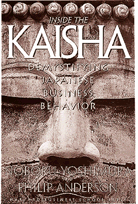"Inside the Kaisha: Demystifying Japanese Business Behavior" by Noboru Yoshimura and Philip Anderson
Inside the Kaisha:Demystifying Japanese Business Behavior by Noboru Yoshimura and Philip Anderson (259 pages, Harvard Business School Press, 1997)
(originally published by Booz & Company) It hardly seems credible now that less than 10 years ago the "West" worked itself into a fine panicked lather about Japan's growing economic hegemony in the Pacific and what appeared to be an increasing domination of global markets. American journalists, alternately jingoistic and full of self-doubt, predicted the death of a West hampered by outmoded production practices, lazy workers and a short-term outlook. Japanese culture, they charged, was organized to promote economic goals and thus gave the Japanese an unfair advantage in international competition. Cultural values allowed the Japanese to be, it seemed to some American businesspeople, duplicitous and hypocritical. Why could they never just say what they meant? Kaisha, the large Japanese companies that provide lifetime employment to some 40 percent of the work force, were a social institution more than an economic one, critics said. No wonder they could drive a miracle.
It hardly seems credible now that less than 10 years ago the "West" worked itself into a fine panicked lather about Japan's growing economic hegemony in the Pacific and what appeared to be an increasing domination of global markets. American journalists, alternately jingoistic and full of self-doubt, predicted the death of a West hampered by outmoded production practices, lazy workers and a short-term outlook. Japanese culture, they charged, was organized to promote economic goals and thus gave the Japanese an unfair advantage in international competition. Cultural values allowed the Japanese to be, it seemed to some American businesspeople, duplicitous and hypocritical. Why could they never just say what they meant? Kaisha, the large Japanese companies that provide lifetime employment to some 40 percent of the work force, were a social institution more than an economic one, critics said. No wonder they could drive a miracle.
The luster is off the Japanese economic miracle now, and Japan has become just another wobbly advanced industrial economy. It is often reported in the United States that the big Japanese companies are beginning to act more like American corporations, shedding workers at will to save costs, but in fact "downsizing" American-style is still extremely rare in Japan. Miracles come, miracles go; the kaisha, it turns out, remain pretty much the same. Clearly, they could not have been the sole driving force of Japan's success.
Nor were they a fully elaborated expression of Japanese values, as Noboru Yoshimura and Philip Anderson explain in their interesting new book, Inside the Kaisha: Demystifying Japanese Business Behavior. Mr. Yoshimura, who is now a vice president of the Japan merchant banking group at Bankers Trust, was an M.B.A. student at Cornell University when he met Mr. Anderson, then an organizational behavior specialist teaching at Cornell. Mr. Anderson had read and researched extensively on Japanese management; he taught his students the mainstream American view of Japanese companies. "He depicted Japanese firms as 'theory Z' organizations," the authors write, "where culture is the primary control mechanism; described the paramount importance of harmony to the Japanese; and discussed the Japanese sense of obligation." He recounted the necessity of working through personal relationships and go-betweens and of understanding the role of elite universities and recruiting. He described the importance of negotiating and renegotiating.
The familiar approach made perfect sense to the uncritical American students. The Japanese students, however, some 40 of them with business experience, felt Mr. Anderson had a grip on part of the Japanese management approach but not the whole thing. Interestingly, they could not agree themselves on a coherent story line. Reactions differed, company by company, and most of the students had worked at only one company. After several conversations with Mr. Yoshimura, Mr. Anderson realized that looking for general rules about Japanese organizations and organizational behavior was beside the point. To "demystify" Japanese management, Mr. Anderson and Mr. Yoshimura chose to look not at the finished organization but at the process people go through — their socialization — to become members of the organization.
The authors are not the first to apply socialization theory to an aspect of Japanese culture. But they do it with more sophistication, if only because they are not making any global claims about Japanese psychology. They describe in detail the typical life of a sarariiman (salaryman), from the moment his — there is no typical life of a female sarariiman — parents set him on course from good nursery schools to good secondary schools to good universities to a job at a good company. In looking at several life histories, they found some common experiences that helped explain how the kaisha work.
A few things stand out: the importance the system places on context; the importance of learning correct behavior by observing models; the extremes to which the Japanese expect each other to go to avoid any form of embarrassment, to self and others, and the general belief that process is more important than outcome, that is, that doing something right is more important than attaining a goal.
Americans often have problems with these "principles." We expect people to behave consistently from one situation to another. We don't have many ritualized forms of interaction to make insulting mistakes on. Because we do not have many rituals, we have fewer ways to be socially embarrassed; a faux pas may even be endearing. We are goal-oriented, perhaps to a fault.
Is there a way across the cultural gap? The book does a good job of explaining how the principles work in the context of the kaisha. It ends with a chapter describing, in essence, what bothers sarariimen about their American counterparts and what Americans can do about it. Most important, they say, try to learn the Japanese language. Language always reflects culture, but Japanese does more so than most. Hierarchy, which is so important in the kaisha, is encoded in the language, primarily in the choice of formal or informal forms of speech. Language is the primary mechanism recognizing status. Americans who make no attempt at the language can never understand the kaisha, according to the sarariimen interviewed for this book.
They do not expect Americans to speak perfectly fluent Japanese, but they recognize making an effort as a gesture of respect for the kaisha system. And since that system is likely to survive whatever roller-coaster ride the international economy may take it on in the next few years, it would not hurt to understand it better. ![]()
Reprint No. 97411


